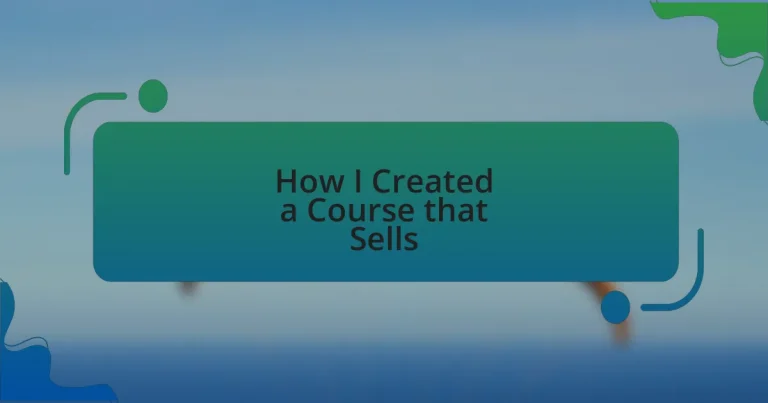Key takeaways:
- Travel blogging success revolves around creating authentic, engaging narratives that resonate with your audience’s interests and needs.
- Selecting a specific niche is crucial for connecting deeply with readers and providing valuable content that fills market gaps.
- Feedback and clarity in content are essential for course development, helping to refine materials and enhance the learning experience.
- Measuring success involves analyzing sales metrics, student engagement, and long-term impact to understand the course’s effectiveness and areas for improvement.
Author: Evelyn Hartley
Bio: Evelyn Hartley is a bestselling author known for her compelling historical novels that delve into the complexities of human relationships. With a background in literature and a passion for storytelling, she crafts richly detailed narratives that transport readers to different eras. Her award-winning debut novel, “Whispers of the Past,” was praised for its vivid characters and intricate plots. When she’s not writing, Evelyn enjoys exploring antique shops and researching the fascinating stories behind forgotten artifacts. She resides in a charming cottage in Vermont, where she draws inspiration from the beauty of nature and the stories it holds.
Understanding travel blogging basics
When I first stepped into the world of travel blogging, I had no clue where to begin. The basics of travel blogging involve creating authentic content that resonates with readers. It’s not just about sharing destinations; it’s about crafting a narrative that draws people in, painting pictures with words that evoke emotions and inspire wanderlust.
Understanding your audience is crucial. I remember the first time I realized my writing wasn’t just for me; it was for fellow adventurers looking for tips and inspiration. What are readers looking for? Common questions often revolve around how to travel on a budget or the must-see spots in a particular country. Focusing on these aspects can truly elevate your blog.
While technical skills matter—think SEO, photography, and social media—what really sets a good travel blog apart is voice. I vividly recall receiving comments from readers who felt they had traveled alongside me, simply because of the way I shared my experiences. Have you considered how your unique perspective adds value to your narrative? It’s in the nuances of your own stories that you can spark connections and cultivate a loyal audience.
Choosing a niche for travel
Choosing a niche in travel blogging is a pivotal decision that can shape your entire journey. I remember when I first tried to cover everything from luxury travel to backpacker tips; it felt overwhelming and scattered. Eventually, I found that honing in on adventure travel allowed me to connect deeply with a specific audience that shares my passion for the thrill of exploration.
When deciding on your niche, consider what excites you the most. Do you have a love for culinary adventures, solo traveling, or eco-friendly escapes? I found my niche when I realized how passionate I was about sustainable travel after a trip where I volunteered at a wildlife sanctuary. That experience not only enriched my travels but also helped me create content that resonates with like-minded readers seeking both adventure and conservation.
Moreover, it’s essential to understand the market landscape. What gaps exist that you can fill with your unique voice? Reflecting on my early days, I noticed many blogs would focus on popular destinations without offering insider tips. That’s where I stepped in, sharing lesser-known gems and practical advice. By identifying a niche that aligns with your interests and offers value to readers, you’re setting the foundation for a blog that truly stands out.
Identifying target audience for courses
When it comes to identifying your target audience for a course, start by reflecting on who would benefit most from what you have to offer. I remember creating my first course; I had a vision but struggled to pinpoint who exactly would find it valuable. After some thoughtful consideration, I realized that aspiring travel bloggers who desired practical, hands-on guidance were my ideal audience. This clarity helped me tailor my content effectively.
Additionally, think about the questions your audience might have. What are their pain points? For instance, I discovered that many beginners feel overwhelmed by the technical aspects of blogging. By acknowledging their struggles, I crafted modules focused explicitly on simplifying those complexities, which made my course resonate even more with them. Engaging with prospective students through surveys or social media can also refine this understanding.
Don’t underestimate the power of community in shaping your audience. In my journey, I found that joining travel blogging groups exposed me to countless individuals eager to learn. Listening to their experiences and needs not only enriched my perspective but also inspired me to create content that genuinely connects with them. Understanding your audience isn’t just an exercise; it’s about forming genuine connections that enhance the learning experience.
Creating valuable content for learners
Creating valuable content for learners hinges on understanding what they truly need. I recall a moment when I received feedback from a participant who expressed frustration over a lack of real-world examples in many online courses. This pushed me to incorporate case studies from my own travel experiences, illustrating concepts in a way that felt relevant and relatable. Have you ever taken a course that lacked practical applications? It’s frustrating, isn’t it? I made it a priority to ensure my learners could directly relate the content to their journeys.
Additionally, I found that incorporating interactive elements significantly enhances engagement. One of the most rewarding parts of my course was when I started hosting live Q&A sessions. Learners appreciated the chance to ask questions in real-time and share their own stories. It created a sense of community and support that went beyond the topics at hand. Who wouldn’t want to be part of a learning space where everyone shares their travel dreams and tips?
Also, I stress the importance of regularly updating content to keep it fresh and relevant. I’ve made it a practice to revisit my course materials at least once a year, integrating new trends in travel blogging and insights from my latest adventures. This not only shows my commitment to providing value but also inspires learners to stay informed and adaptable in their own journeys. Isn’t it exciting to think about how much there is still to discover?
Marketing strategies for course promotion
One effective strategy I discovered for promoting my course is leveraging social media platforms. Initially, I shared snippets of behind-the-scenes content on my travel experiences, sparking interest and discussions among my followers. I remember posting an engaging story about a travel mishap that turned into a valuable lesson, which prompted questions and excitement about what would be covered in my course. It was a fantastic way to create buzz before launch—have you ever noticed how a captivating story can draw people in?
Email marketing also played a crucial role in my promotional efforts. I started building a list of interested travelers who wanted tips and insights related to travel blogging. When it came time to launch the course, I crafted personalized emails detailing how the course could help them overcome common challenges. This approach not only felt authentic but also fostered a sense of connection. Have you ever opened an email that felt like it was speaking directly to you? That’s the experience I aimed to create.
Lastly, collaborating with other travel bloggers has been a game-changer for me. I reached out for guest posts and cross-promotions, allowing us to share audiences while providing value to our respective communities. This way, I tapped into their established trust and credibility. It’s fascinating how sharing your platform can yield growth for everyone involved—have you ever participated in a collaboration that resulted in unexpected opportunities? That’s the beauty of community over competition.
Lessons learned from course creation
Creating a course taught me that feedback is essential. After my initial launch, I solicited responses from early participants and was surprised by how much I learned. One traveler mentioned that they struggled with the technical aspects of blogging, which led me to realize I needed to offer more supportive resources. Isn’t it interesting how insights from others can guide you in unexpected ways?
Another lesson came through the power of clarity in content. I vividly recall a week when I received feedback about a particularly confusing module. It hit me hard; what I considered clear was not landing with my audience. This experience reinforced the importance of simplicity and structure, ensuring every lesson is digestible. Have you ever tried explaining something you thought was straightforward only to find your audience lost?
Finally, I discovered the value of patience during the course creation process. There were moments of doubt and frustration, especially when sales didn’t meet my expectations right away. But as time passed and I continued to refine my content and marketing efforts, I witnessed gradual growth. Patience has its rewards—how do you measure success when outcomes are not immediately visible?
Measuring success of course sales
To effectively measure the success of course sales, I rely heavily on sales metrics. Analyzing total sales, conversion rates, and customer feedback provides concrete insights on how my course is performing. I remember the excitement I felt when my first month’s sales surpassed my expectations, but it was the follow-up surveys that really shed light on what resonated with my audience. Have you ever noticed how the numbers can tell a story, often revealing what you never anticipated?
Moreover, I pay close attention to student engagement levels. Tracking how often participants log in, complete modules, and utilize provided resources helps me understand their experience. It brings me joy when I see a spike in activity during days when I host live Q&A sessions, as it confirms that live interaction keeps my audience motivated. Isn’t it fascinating how engagement levels can correlate directly with sales?
Lastly, I think about the long-term impact of my course on the participants. I strive to create lasting relationships beyond the sale, so I assess repeat purchases and testimonials as indicators of success. Reflecting on a heartfelt message I received from a student who transitioned from hobbyist to a full-time travel blogger really hit home for me, showcasing that my course is more than just a one-time transaction. How do you gauge the enduring effect of what you create?




